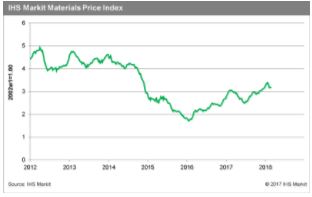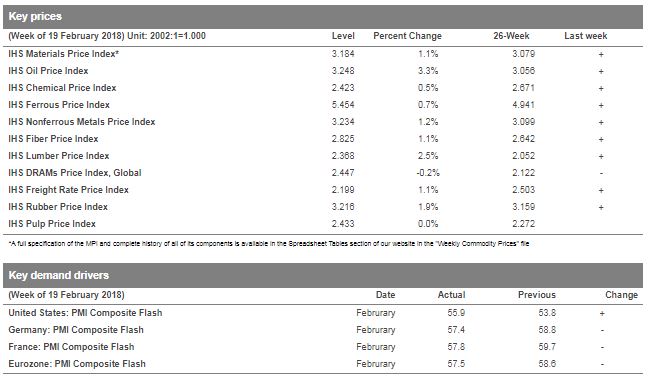| Week ending March 2, 2018 |
The MPI rebounds on oil supply concerns
|
Temporary supply concerns in oil markets drive up commodity prices
The IHS Markit Materials Price Index (MPI) rose 1.1% last week, breaking a string of three consecutive declines. Price increases were widespread, with eight of the MPI's ten subindexes climbing. Oil and lumber were the biggest movers, increasing 3.3% and 2.5%, respectively.
Supply concerns drove crude oil prices higher last week. In the United States, a rapid pullback in crude imports led to an unexpected decline in oil inventories. Overseas, violent protests in Libya forced authorities to suspend production at the el-Feel oilfield, taking 60,000 barrels per day (b/d) of production offline. Despite the reactions in oil markets last week, we believe these supply concerns, as well as the price gains, are only temporary. In lumber markets, tight buying conditions for British Columbia softwood pushed up prices, but these gains should also not persist—prices are reaching a peak, as increasing US capacity will cap price increases moving forward.
The Purchasing Managers Index (PMI) Composite Flash Indices released last week continued to highlight the strength of the global economy. In the United States, the service sector rebounded from recent softness, while manufacturing remained steady, pushing the index to a 27-month high of 55.9. In the Eurozone, the PMI Composite Flash showed that the strength seen at the start of the year has persisted. News last week was not uniformly good, however. The Chinese government's takeover of insurance giant Anbang provided a reminder that credit growth is slowing in China; this slowdown will have consequences for growth and act as a check on commodity prices.
|
|
|
| | IHS Materials Price Index |  |
|
| | 
| Market Insight
For an overview of the IHS Materials Price Index, view this video.
Get the Materials Price Index delivered to your in-box weekly.
Subscribe here.
|
|  |
| | |
|
| Industrial Materials: Prices |  |
| Key Prices & Demand Drivers |  |
Construction Labor Costs Reach Highest Level in Almost Three Years, IHS Markit Says
|
Construction costs rose again in November, according to IHS Markit and the Procurement Executives Group (PEG). |
The current headline IHS Markit PEG Engineering and Construction Cost Index registered 60.2, supported by strong figures in both the materials/equipment and labor sub-indexes. The materials/equipment price index was 60.9 in November, moving up from the October figure of 58.9. Price increases were widespread. Current subcontractor labor prices rose at a fast pace in November: the index figure came in at 58.5, the highest reading since December 2014. “Subcontractor rates continued to accelerate over November and expectations for future increases reached a five-year high,” said Emily Crowley, principal economist - pricing and purchasing, IHS Markit. “Tightening labor market conditions combined with an uptick in activity are driving expectations of future rate increases. Currently the U.S. South and West are having the most trouble finding workers leading to stronger wage escalation, whereas the end of major projects in Eastern Canada are keeping pressure off of wages in that region.”
| | Learn More |
|
| About IHS Pricing & Purchasing | | The IHS Pricing & Purchasing Service | The IHS Pricing & Purchasing Service enables supply chain cost savings by providing timely, accurate price forecasts and cost analysis. Armed with a better understanding of suppliers' cost structures and market dynamics, organizations can effectively negotiate prices, strategically time buys, and boost the bottom line.
With a database of more than 80,000 historic prices and thousands of price, wage and input cost forecasts, IHS offers more coverage than any other provider in the market. IHS has been providing forecasts of key commodity, labor, and input costs since 1970 -- helping define the purchasing advice industry. | | Learn More |
|
| Commodity Price Forecasts & Supply Chain Cost Benchmarking. Learn More | | |
|
|
|
